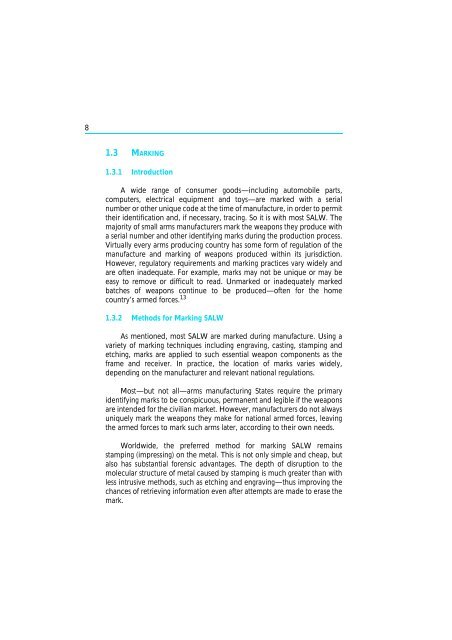The Scope and Implications of a Tracing Mechanism for Small Arms ...
The Scope and Implications of a Tracing Mechanism for Small Arms ...
The Scope and Implications of a Tracing Mechanism for Small Arms ...
Create successful ePaper yourself
Turn your PDF publications into a flip-book with our unique Google optimized e-Paper software.
8<br />
1.3 MARKING<br />
1.3.1 Introduction<br />
A wide range <strong>of</strong> consumer goods—including automobile parts,<br />
computers, electrical equipment <strong>and</strong> toys—are marked with a serial<br />
number or other unique code at the time <strong>of</strong> manufacture, in order to permit<br />
their identification <strong>and</strong>, if necessary, tracing. So it is with most SALW. <strong>The</strong><br />
majority <strong>of</strong> small arms manufacturers mark the weapons they produce with<br />
a serial number <strong>and</strong> other identifying marks during the production process.<br />
Virtually every arms producing country has some <strong>for</strong>m <strong>of</strong> regulation <strong>of</strong> the<br />
manufacture <strong>and</strong> marking <strong>of</strong> weapons produced within its jurisdiction.<br />
However, regulatory requirements <strong>and</strong> marking practices vary widely <strong>and</strong><br />
are <strong>of</strong>ten inadequate. For example, marks may not be unique or may be<br />
easy to remove or difficult to read. Unmarked or inadequately marked<br />
batches <strong>of</strong> weapons continue to be produced—<strong>of</strong>ten <strong>for</strong> the home<br />
country’s armed <strong>for</strong>ces. 13<br />
1.3.2 Methods <strong>for</strong> Marking SALW<br />
As mentioned, most SALW are marked during manufacture. Using a<br />
variety <strong>of</strong> marking techniques including engraving, casting, stamping <strong>and</strong><br />
etching, marks are applied to such essential weapon components as the<br />
frame <strong>and</strong> receiver. In practice, the location <strong>of</strong> marks varies widely,<br />
depending on the manufacturer <strong>and</strong> relevant national regulations.<br />
Most—but not all—arms manufacturing States require the primary<br />
identifying marks to be conspicuous, permanent <strong>and</strong> legible if the weapons<br />
are intended <strong>for</strong> the civilian market. However, manufacturers do not always<br />
uniquely mark the weapons they make <strong>for</strong> national armed <strong>for</strong>ces, leaving<br />
the armed <strong>for</strong>ces to mark such arms later, according to their own needs.<br />
Worldwide, the preferred method <strong>for</strong> marking SALW remains<br />
stamping (impressing) on the metal. This is not only simple <strong>and</strong> cheap, but<br />
also has substantial <strong>for</strong>ensic advantages. <strong>The</strong> depth <strong>of</strong> disruption to the<br />
molecular structure <strong>of</strong> metal caused by stamping is much greater than with<br />
less intrusive methods, such as etching <strong>and</strong> engraving—thus improving the<br />
chances <strong>of</strong> retrieving in<strong>for</strong>mation even after attempts are made to erase the<br />
mark.
















